AI-Powered Content Creation: A Game-Changer for 2024

Content creation has entered its watershed era. 2024 marks the era when artificial intelligence was no longer just a fancy dream to appear in a sci-fi movie; it’s already an extremely potent tool that creates and redrafts the very fabric of creating content for businesses and individuals. It has nothing to do with automation; it is an overlying efficiency, creativity, and reach aspect. Here’s a closer view of how AI was revolutionizing content in 2024:
I. Improved Efficiency and Productivity:
Speed and Scalability:
It can produce multiple formats of content—from blog posts and articles to social media updates and marketing copy—at an unprecedented speed. Scalability enables companies to produce a much larger volume of content in a far shorter period of time, catering to diverse audiences and platforms. Content that would have taken considerable human hours-writing product descriptions or generating social media posts-is now easily and effectively accomplished with the help of AI tools.
Content Repurposing:
Automated by AI It automatically repurposes what has previously been delivered in content into many different formats. For instance, a single blog post can turn itself into several social media posts, short videos, infographics, or even an email newsletter. Through this method, reach is maximized, while the effort is redundant only to a limited extent. It also helps ensure that the content presents itself as consistent across its various deployment points but with a considerable saving in terms of time and resources.
This aspect ensures that the workflow of AI tools is well streamlined with the natural workflow of content creation. It will undertake tasks such as grammar and spell checks, image captioning, and even scheduling, freeing human creators to focus on strategic editing, direction, and creativity. In that way, the combination of human intelligence and AI makes the workflow more efficient in itself.
Unlocking Creativity and Innovation
One can overcome writer’s block using AI tools or as effective brainstorming partners to brainstorm ideas, providing suggestions and alternatives, thus helping one overcome the block of writer’s block. It may suggest alternative formulations, look at different matters of perspectives, and even propose appropriate keywords and topics for discussion in accordance with the current trends and preferences of the audience.
By analyzing vast information datasets, AI identifies emerging trends, popular topics, and content gaps. Creators can, therefore, design original ideas that appeal to their targeted audience and avoid the crowdedness of the digital landscape. Such a data-driven approach reduces the risk of producing irrelevant or unengaging content.
Content Personalization:
AI algorithms enable personalizing content in a manner aligned with individual user preferences and behaviors. This will thus allow for the generation of targeted messages and customized experiences that enhance engagement with the user and create stronger brand loyalty. In today’s fragmented digital environment, this personalized approach will prove crucial.
III. Quality Optimization and Content Effectiveness
Improve readability and SEO: AI tools can scan the content to make sure that it is readable, clear, and understandable by the targeted audience. It may optimize the content for a search engine by providing more related keywords, improving metadata, and making sure all on-page SEO elements are used appropriately. This way, it improves search rankings and also brings more organic traffic.
Using artificial intelligence for grammar and style consistency:
AI can automatically scan content to check for grammar and spelling errors as well as style, and the result will always be consistency in all content. This will eliminate errors and overall professionalism and credibility in content. Maintaining a consistent style and tone is particularly crucial for brand-identity building.
Data-Driven Content Enhancements:
With AI tools, possible areas of enhancement can be determined by reviewing the performance metrics of a piece of content—its engagement rate and bounce rate, for example. Ensuring that data-driven improvements take place means that creators enhance their content strategy, thereby maximizing the effect.
IV. Challenges and Considerations
Ethical Issues The emergence of AI-generated content necessitates and raises various ethical issues-plagiarism, algorithm bias, and the ousting of human writers; thus, there is a need for responsible and ethical application of AI, with full transparency and accountability.
Human checking is, in fact, the golden rule. Automation can take care of most of the work. Nonetheless, people need to scrutinize AI-generated content and edit it according to accuracy, relevance, and brand guidelines. After all, human touch adds nuance, originality, and emotional intelligence that machines can only mimic through complicated algorithms.
Data Privacy and Security:
AI tools rely highly on large datasets of user information, which raises great concerns about data privacy and security. Thus, being choosy with good providers who have prioritized data protection or adhering to all the regulations required for the same has to be used.
AI will not be a replacement of humans for creating, but super-advanced tools are to equip the human race in becoming more productive, creative, and efficient. Businesses, as well as individuals, will be unlocking unprecedented opportunities for creating engaging, high-quality content that resonates with their target audience and produces impactful results in 2024 and beyond by responsibly and strategically embracing AI. The future of content creation looks collaborative, where the best of human ingenuity is combined with the power of artificial intelligence.
